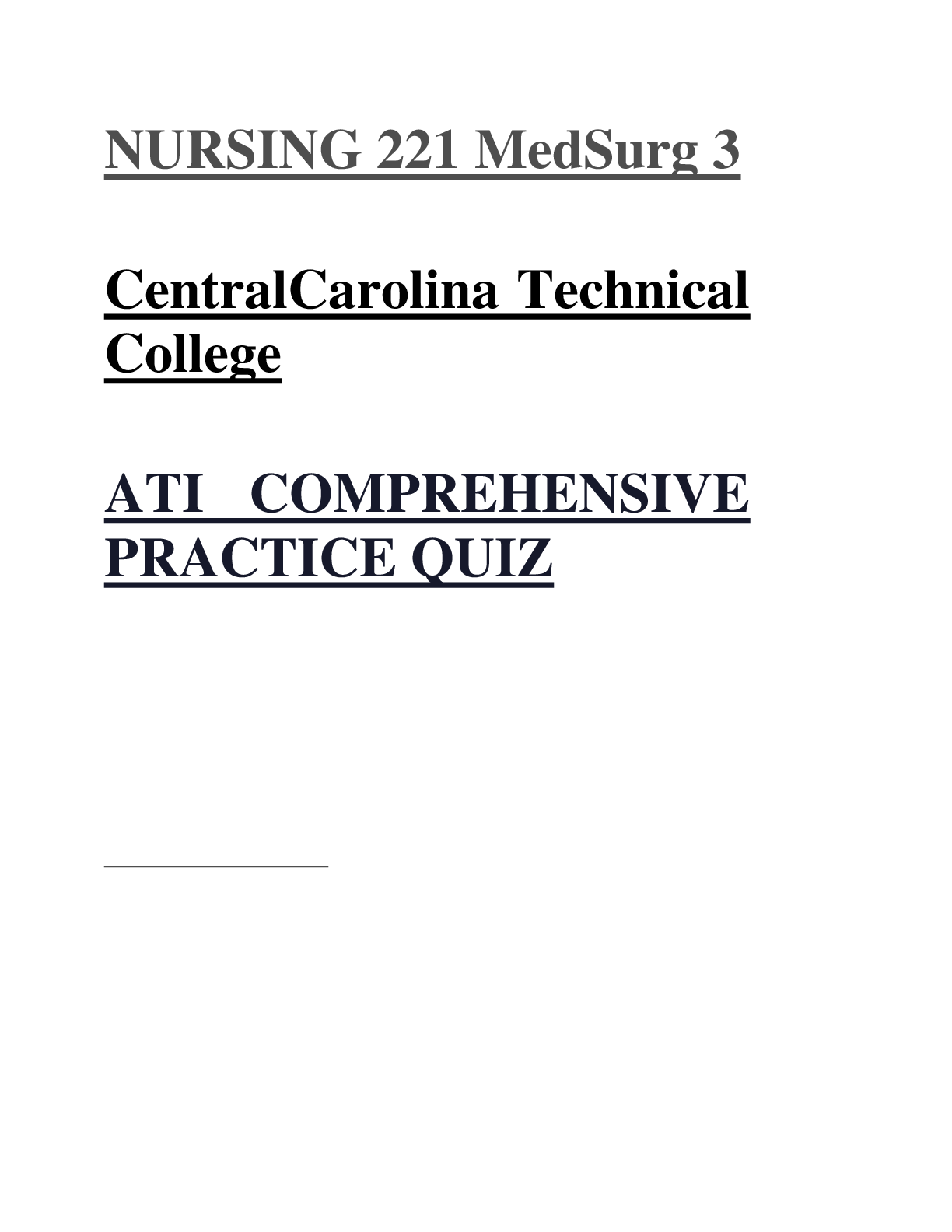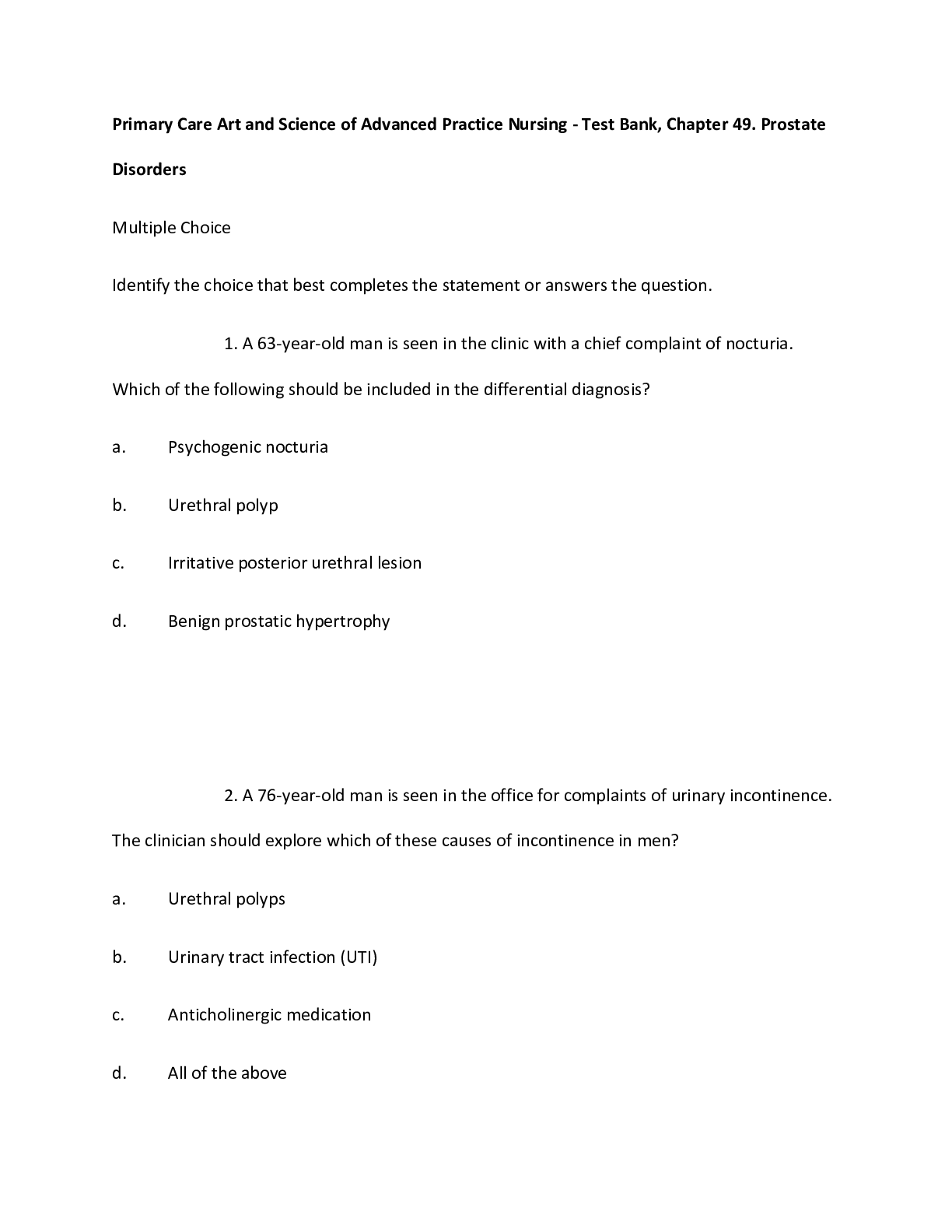
NURSING 221 MedSurg 3 ATI COMPREHENSIVE PRACTICE QUIZ ATI COMPREHENSIVE PRACTICE QUIZ
*NURSING > QUESTIONS & ANSWERS > ATI Primary Care Art and Science of Advanced Practice Nursing - Test Bank, Chapter 49. Prostate Diso (All)
ATI Primary Care Art and Science of Advanced Practice Nursing - Test Bank, Chapter 49. Prostate Disorders, Latest Questions and Answers with Explanations, All Correct Study Guide, Download to Score A ... Primary Care Art and Science of Advanced Practice Nursing - Test Bank, Chapter 49. Prostate Disorders Multiple Choice Identify the choice that best completes the statement or answers the question. 1. A 63-year-old man is seen in the clinic with a chief complaint of nocturia. Which of the following should be included in the differential diagnosis? a. Psychogenic nocturia b. Urethral polyp c. Irritative posterior urethral lesion d. Benign prostatic hypertrophy 2. A 76-year-old man is seen in the office for complaints of urinary incontinence. The clinician should explore which of these causes of incontinence in men? a. Urethral polyps b. Urinary tract infection (UTI) c. Anticholinergic medication d. All of the above 3. A 14-year-old male is seen with complaints of severe testicular pain. The clinician suspects testicular torsion. Which of the following is the appropriate action? a. Refer to a urologist immediately. b. Obtain a computed tomography (CT) scan. c. Instruct the patient to elevate the scrotum. d. Prescribe ibuprofen. 4. An 82-year-old man is seen in the primary care office with complaints of dribbling urine and difficulty starting his stream. Which of the following should be included in the list of differential diagnoses? a. Benign prostatic hyperplasia (BPH) b. Parkinson’s disease c. Prostate cancer d. All of the above 5. Which of the following would be an appropriate treatment for a patient with mild BPH? a. Refer to a urologist for surgery. b. Prescribe a trial of tamsulosin. c. Recommend cranberry supplements. d. Reevaluate symptoms in 1 to 3 months. 6. A 30-year-old man is seen with a chief complaint of loss of libido. Which of the following laboratory tests would help establish a diagnosis? a. Testosterone level b. Prostate-specific antigen c. Nocturnal penile tumescence and rigidity d. Prolactin level 7. Which of the following should be considered in a patient presenting with erectile dysfunction? a. Diabetes mellitus b. Hypertension c. Atherosclerosis d. All of the above 8. A 35-year-old man presents with complaints of painful erections, and he notices his penis is crooked when erect. What is the most likely diagnosis? a. Peyronie’s disease b. Damage to the pudendal artery c. Scarring of the cavernosa d. All of the above 9. The patient with BPH is seen for follow-up. He has been taking finasteride (Proscar) for 6 months. The clinician should assess this patient for which of these side effects? a. Erectile dysfunction b. Glaucoma c. Hypotension d. Headache 10. The clinician should prescribe an antibiotic that covers which of these organisms for a patient with acute prostatitis? a. Gram-positive cocci b. Gram-negative cocci c. Gram-positive bacillus d. Gram-negative bacillus 11. The 56-year-old man with chronic prostatitis should be treated with trimethoprim 80 mg- sulfamethoxazole 400 mg (TMP-SMX, Bactrim) for how long? a. 3 to 7 days b. 14 to 21 days c. 3 to 6 weeks d. 6 to 12 weeks 12. A 46-year-old man presents with urinary hesitancy and low back pain. He has no history of UTI. Digital rectal examination (DRE) reveals a normal prostate, and a diagnosis of prostatodynia is made. Which is the appropriate treatment? a. Terazosin 2 mg PO once a day b. Ice pack to the scrotal area c. Saw palmetto 320 mg per day d. All of the above 13. A 23-year-old sexually active man is seen in the clinic with unilateral painful testicular swelling, and he is diagnosed with epididymitis. In order to prescribe the correct drug, the clinician must understand that which of these is the most common causative organism? a. Escherichia coli b. Staphylococcus aureus c. Chlamydia trachomatis d. Pseudomonas aeruginosa 14. Which test is used to confirm a diagnosis of epididymitis? a. Urinalysis b. Gram stain of urethral discharge c. Complete blood cell count with differential d. Ultrasound of the scrotum 15. Treatment for epididymitis includes which of the following? a. Warm sitz baths b. Scrotal elevation c. Masturbation d. All of the above 16. Which of the following data is indicative of testicular torsion? a. Absent cremasteric reflex b. Pain relieved on testicular elevation c. Testicle very low in the scrotum d. Swollen scrotum with “red dot sign” 17. A 60-year-old man presents with an enlarged scrotum. The clinician uses a penlight to transilluminate the scrotum. In a patient with a hydrocele, what would the clinician expect to find? a. The scrotum will be dark. b. The scrotum will appear light pink or yellow. c. The scrotum will appear milky white. d. The internal structures will be clearly visible. 18. During a DRE on a 75-year-old man, the clinician suspects the patient has prostate cancer. What physical finding should make the clinician suspicious? a. An enlarged rubbery gland b. A hard irregular gland c. A tender gland d. A boggy gland 19. A 78-year-old man is diagnosed with C2 prostate cancer, and he asks the clinician what that means. In order to answer the patient, the clinician must have which of these understandings of the Jewett rating system? a. The cancer involves the seminal vesicles. b. There is metastatic disease to regional lymph nodes. c. The cancer is confined to the capsule. d. There is metastasis to distant organs. 20. A 58-year-old patient has been receiving leuprolide as treatment for prostate cancer. The clinician should instruct the patient about which of these side effects? a. Risk of osteoporosis b. May have hot flushes c. May have impotence d. All of the above 21. A 22-year-old male is seen in the clinic because he found a hard lump in his testicle when performing testicular self-examination (TSE). Which of the following should be included in the list of differential diagnoses? a. Testicular cancer b. Inguinal hernia c. Varicocele d. All of the above 22. What is the treatment of choice for a patient diagnosed with testicular cancer? a. Radical orchidectomy b. Lumpectomy c. Radiation implants d. All of the above 23. A patient with testicular cancer is being followed after completing treatment 1 year ago. He has been symptom-free with no evidence of disease. How often should he have a CT scan? a. Every month b. Every 3 to 4 months c. Every 6 to 12 months d. Every year True/False Indicate whether the statement is true or false. 1. Patients treated for Neisseria gonorrhoeae also should be treated for Chlamydia trachomatis. 2. Hepatitis A is considered a sexually transmitted infection by the Centers for Disease Control and Prevention. [Show More]
Last updated: 3 years ago
Preview 1 out of 13 pages

Buy this document to get the full access instantly
Instant Download Access after purchase
Buy NowInstant download
We Accept:

, Latest Questions and Answers with Explanations, All Correct Study Guide, Download to Score A.png)
LATEST HESI, ATI, APEA and NCLEX EXAMS BUNDLE, QUESTIONS AND ANSWERS WITH RATIONALE, All Correct Study Guide, Download to Score A
By TopScholar 4 years ago
$247
320
Can't find what you want? Try our AI powered Search
Connected school, study & course
About the document
Uploaded On
May 01, 2021
Number of pages
13
Written in
All
This document has been written for:
Uploaded
May 01, 2021
Downloads
0
Views
144
Scholarfriends.com Online Platform by Browsegrades Inc. 651N South Broad St, Middletown DE. United States.
We're available through e-mail, Twitter, Facebook, and live chat.
FAQ
Questions? Leave a message!
Copyright © Scholarfriends · High quality services·